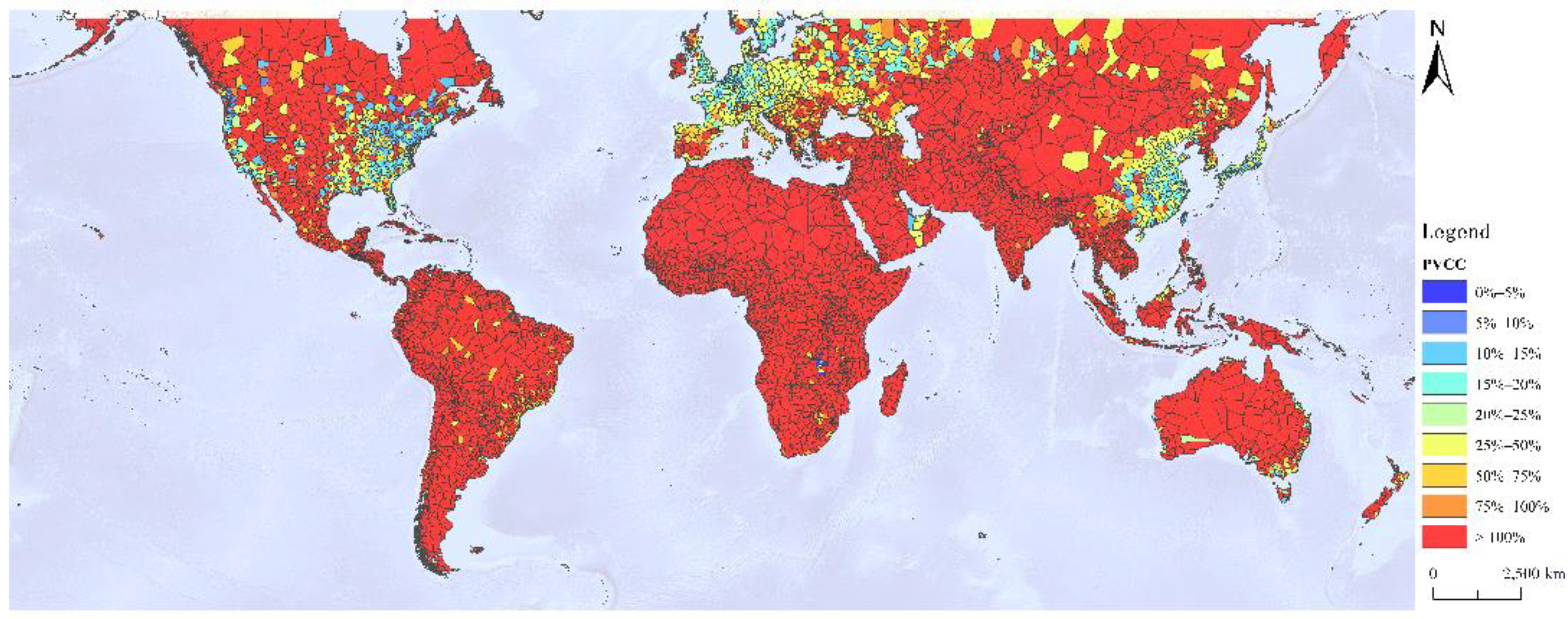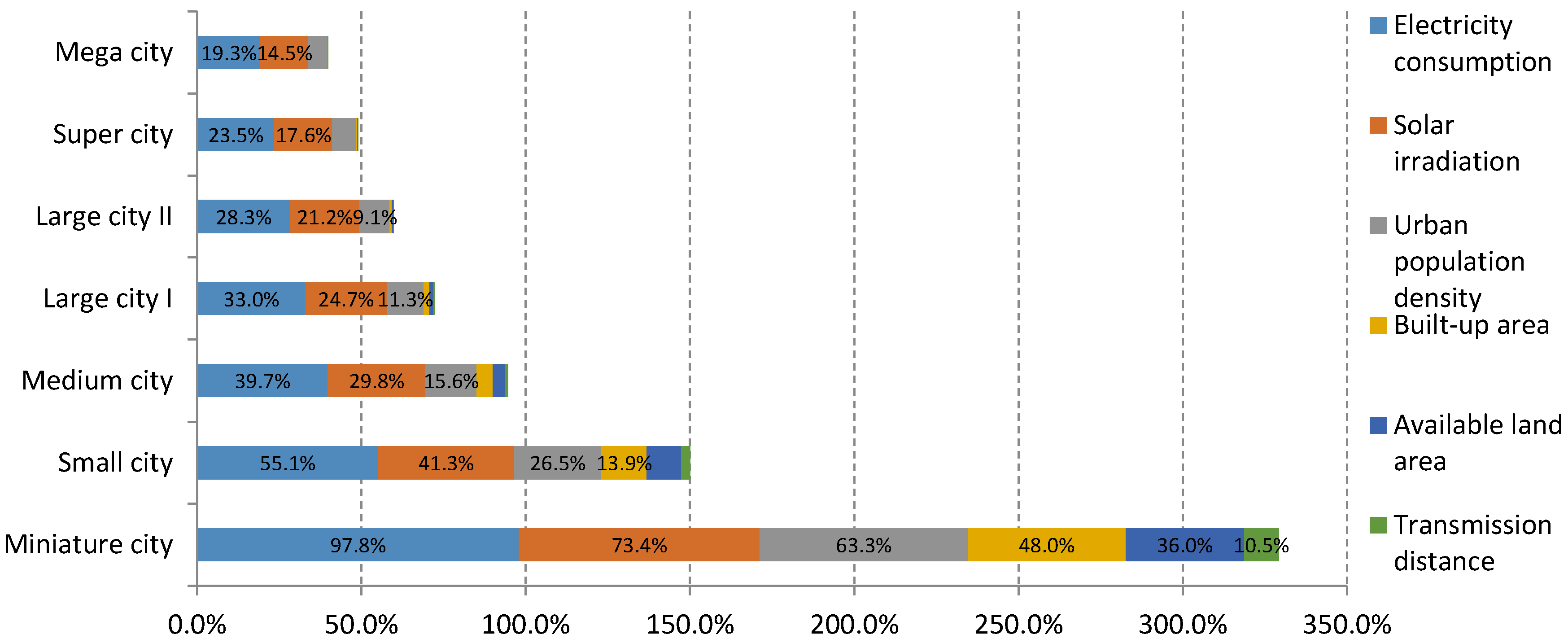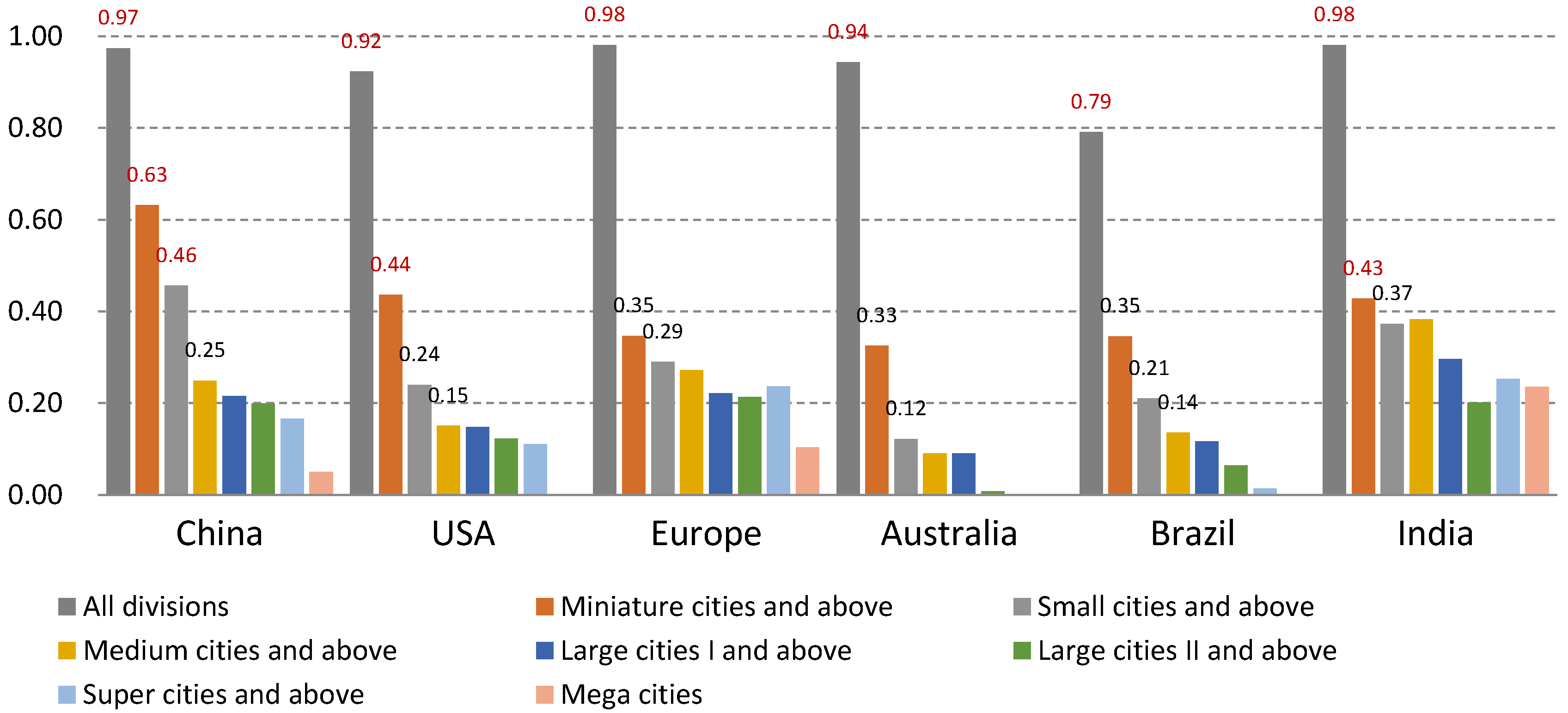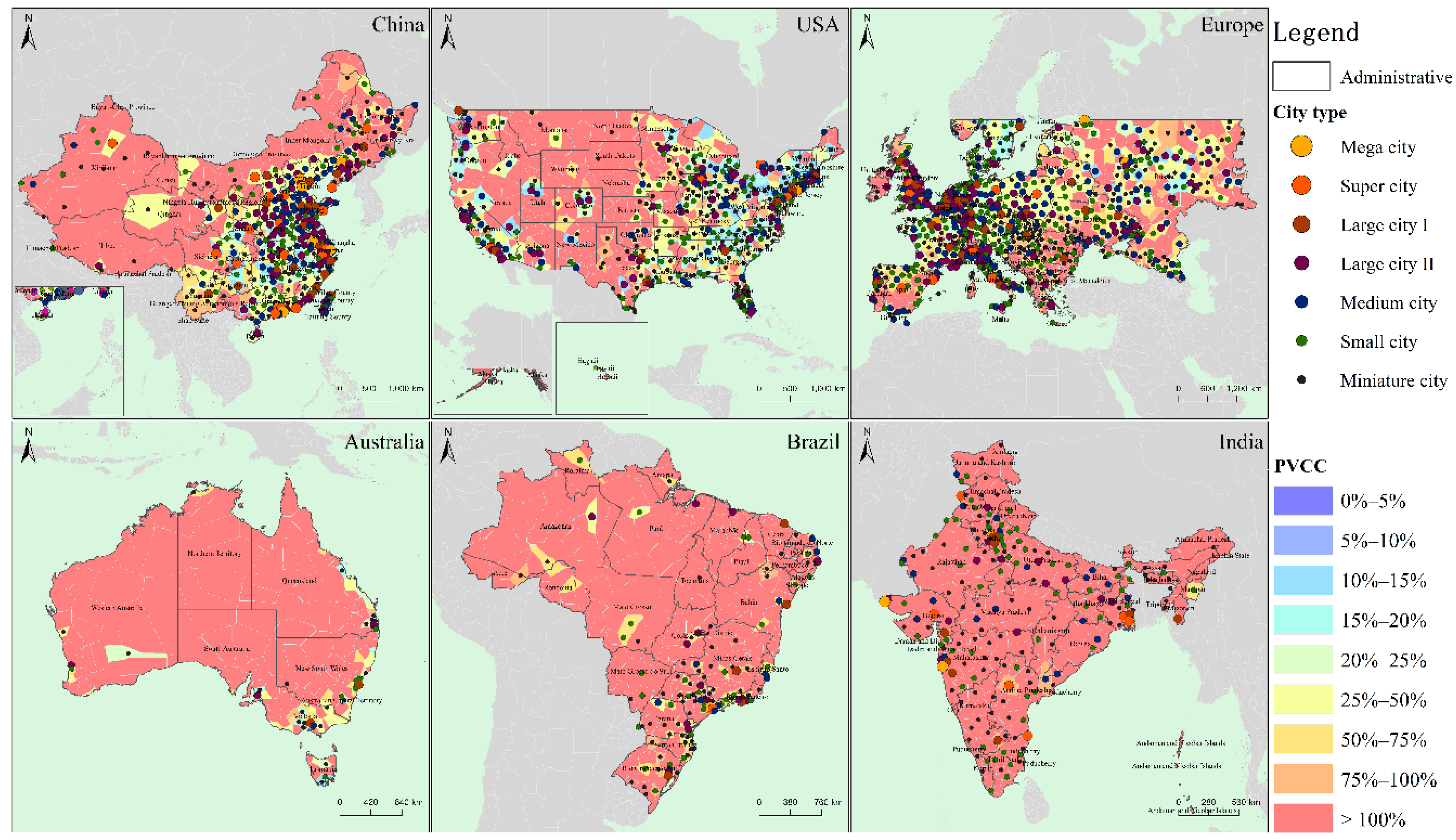Assessment on Global Urban Photovoltaic Carrying Capacity and Adjustment of Photovoltaic Spatial Planning
Abstract
1. Introduction
2. Method
2.1. Photovoltaic Carring Capacity
2.2. Influence Factors
2.3. Urban Geographical Division
2.4. Assessment of PV Generation Potential
2.5. PVCC Assessment
2.6. Data Sources
3. Results and Analysis
3.1. Results of PVCC Assessment
3.2. Sensitivity Analysis of PVCC
3.3. Equilibrium Analysis of PVCC Distribution
4. Discussions
4.1. How Could Different Optimization Strategies Make Changes on the PVCC?
4.2. In Which Section Will the Largest PVCC Distribution Gap Occur?
4.3. What Should Be Done to Adjust the PV Spatial Planning?
4.4. What Is the Essence of Solar PV Spatial Planning?
5. Conclusions
Author Contributions
Funding
Institutional Review Board Statement
Informed Consent Statement
Data Availability Statement
Acknowledgments
Conflicts of Interest
References
- IRENA. Future of Solar Photovoltaic: Deployment, Investment, Technology, Grid Integration and Socio-Economic Aspects (A Global Energy Transformation: Paper); International Renewable Energy Agency: Abu Dhabi, United Arab Emirates, 2019. [Google Scholar]
- IRENA. Renewable Power Generation Costs in 2017; International Renewable Energy Agency: Abu Dhabi, United Arab Emirates, 2018. [Google Scholar]
- Blaschke, T.; Biberacher, M.; Gadocha, S.; Schardinger, I. ‘Energy landscapes’: Meeting energy demands and human aspirations. Biomass Bioenergy 2013, 55, 3–16. [Google Scholar] [CrossRef] [PubMed]
- Stremke, S.; van den Dobbelsteen, A. Sustainable Energy Landscape; CRC Press: Boca Raton, FL, USA, 2013. [Google Scholar]
- Nadaï, A.; Van der Horst, D. Introduction: Landscapes of Energies. Landsc. Res. 2010, 35, 143–155. [Google Scholar] [CrossRef]
- Rees, W.; Wackernagel, M. Urban ecological footprints: Why cities cannot be sustainable—And why they are a key to sustainability. Environ. Impact Assess. Rev. 1996, 16, 223–248. [Google Scholar] [CrossRef]
- Malthus, T.R. An Essay on the Principle of Population; St Paul’s Church-Yard: London, UK, 1798. [Google Scholar]
- UNESCO & FAO. Carrying Capacity Assessment with a Pilot Study of Kenya: A Resource Accounting Methodology for Exploring National Options for Sustainable Development; Food and Agriculture Organization of the United Nations: Rome, Italy, 1985. [Google Scholar]
- Wackernagel, M.; Rees, B. Our Ecological Footprint: Reducing Human Impact on the Earth; New Society Publishers: Philadelphia, PA, USA, 1996. [Google Scholar]
- Vitousek, P.M.; Ehrlich, P.R.; Ehrlich, A.H.; Matson, P.A. Human appropriation of the products of photosynthesis. BioScience 1986, 36, 368–373. [Google Scholar] [CrossRef]
- Odum, H.T. Environmental Accounting: Emergy and Decision Making, 1st ed.; John Wiley and Sons Inc.: New York, NY, USA, 1996. [Google Scholar]
- Feng, Z.M.; Yang, Y.Z.; Yan, H.M.; Pan, T.; Li, P. A review of resources and environment carrying capacity research since the 20th Century from theory to practice. Resour. Sci. 2017, 39, 379–395. [Google Scholar]
- Zhang, L.; Nie, Q.; Chen, B.; Chai, J.; Zhao, Z. Multi-scale evaluation and multi-scenario simulation analysis of regional energy carrying capacity-Case study: China. Sci. Total Environ. 2020, 734, 139440. [Google Scholar] [CrossRef] [PubMed]
- Xue, R. Research on Fuzhou Energy Ecological Footprint and Ecological Carrying Capacity Based on Net Primary Productivity Model. Anhui Agric. Sci. 2020, 48, 64–67. [Google Scholar]
- DeAngelis, D.L.; Zhang, B.; Ni, W.M.; Wang, Y. Carrying Capacity of a Population Diffusing in a Heterogeneous Environment. Mathematics 2020, 8, 49. [Google Scholar] [CrossRef]
- Peng, X.; Zhu, H.; Zhu, E. Evaluation and Analysis of Energy Bearing Capacity in Beijing-Tianjin-Hebei Region: Based on data from 2007–2011. J. Cap. Univ. Econ. Bus. 2015, 17, 15–22. [Google Scholar]
- Mentis, D.; Welsch, M.; Nerini, F.F.; Broad, O.; Howells, M.; Bazilian, M.; Rogner, H. A GIS-based approach for electrification planning-A case study on Nigeria. Energy Sustain. Dev. 2015, 29, 142–150. [Google Scholar] [CrossRef]
- Sabo, M.L.; Mariun, N.; Hizam, H.; MohdRadzi, M.A.; Zakaria, A. Spatial matching of large-scale grid-connected photovoltaic power generation with utility demand in Peninsular Malaysia. Appl. Energy 2017, 191, 63–88. [Google Scholar] [CrossRef]
- Watson, J.J.W.; Hudson, M.D. Regional Scale wind farm and solar farm suitability assessment using GIS-assisted multi-criteria evaluation. Landsc. Urban Plan 2015, 138, 20–31. [Google Scholar] [CrossRef]
- Lee, A.H.; Kang, H.Y.; Lin, C.Y.; Shen, K.C. An Integrated Decision-Making Model for the Location of a PV Solar Plant. Sustainability 2015, 7, 13522–13541. [Google Scholar] [CrossRef]
- Mohajeri, N.; Upadhyay, G.; Gudmundsson, A.; Assouline, D.; Kämpf, J.; Scartezzini, J.L. Effects of urban compactness on solar energy potential. Renew. Energy 2016, 93, 469–482. [Google Scholar] [CrossRef]
- Natanian, J.; Auer, T. Balancing urban density, energy performance and environmental quality in the Mediterranean: A typological evaluation based on photovoltaic potential. Energy Procedia 2018, 152, 1103–1108. [Google Scholar] [CrossRef]
- Sarralde, J.J.; Quinn, D.J.; Wiesmann, D.; Steemers, K. Solar energy and urban morphology: Scenarios for increasing the renewable energy potential of neighbourhoods in London. Renew. Energy 2015, 73, 10–17. [Google Scholar] [CrossRef]
- Lobaccaro, G.; Frontini, F. Solar Energy in Urban Environment: How Urban Densification Affects Existing Buildings. Energy Procedia 2014, 48, 1559–1569. [Google Scholar] [CrossRef]
- Yin, L. Annual Report on World Smart City (2016–2017); Social Sciences Academic Press: Beijing, China, 2017. [Google Scholar]
- IEA. Energy Technology Perspectives 2016: Towards Sustainable Urban Energy Systems; International Energy Agency: Paris, France, 2016. [Google Scholar]
- China Electricity Council. Code for Design of Photovoltaic Power Station (GB50797-2012); China Planning Press: Beijing, China, 2012. [Google Scholar]
- Sophie, B.; Pierre, D.; Van Bogaert, E.; Arino, O.; Kalogirou, V.; Perez, J.R. GLOBCOVER 2009 Products Description and Validation Report; UC Louvain: Leuven, Belgium; ESA Team: Paris, France, 2011. [Google Scholar]
- Hernandez, R.R.; Hoffacker, M.K.; Field, C.B. Efficient use of land to meet sustainable energy needs. Nat. Clim. Chang. 2015, 5, 353–358. [Google Scholar] [CrossRef]
- Available online: http://www.rivermap.cn/ (accessed on 4 November 2019).
- Available online: http://due.esrin.esa.int/page_globcover.php (accessed on 12 October 2019).
- Center for International Earth Science Information Network—CIESIN—Columbia University. Gridded Population of the World, Version 4 (GPWv4): Population Density Adjusted to Match 2015 Revision UN WPP Country Totals; NASA Socioeconomic Data and Applications Center (SEDAC): New York, NY, USA, 2016. [Google Scholar]
- Available online: https://solargis.com/cn/maps-and-gis-data/download (accessed on 4 November 2019).
- Available online: https://data.worldbank.org/ (accessed on 14 July 2020).
- Central Intelligence Agency. The CIA World Facebook 2018–2019; Skyhorse Publishing: New York, NY, USA, 2018.
- Available online: https://www.jinkosolar.com/ (accessed on 26 July 2020).
- The State Council of China. Notice on Adjusting the Standard of City Scale Division; The State Council of China: Beijing, China, 2014.
- Han, J.; Zhao, Q.; Zhang, M. China’s income inequality in the global context. Perspect. Sci. 2016, 7, 24–29. [Google Scholar] [CrossRef]
- National Energy Administration of China. Notice on the Preparation of the 14th Five Year Plan for Renewable Energy Development; Comprehensive Department of National Energy Administration: Beijing, China, 2020.




| Influence Factors | Corresponding Optimization Strategies |
|---|---|
| Solar irradiation | Choosing PV panels of higher conversion efficiency, PV installation on building facades or using inclined roof to gain more irradiation in the same land area |
| Urban population density | When the urban built-up area is constant, population density will change with the variation of building density |
| Built-up area | Urbanization in spatial dimension, urbanization or counter-urbanization, make more land into built-up area or in the opposite |
| Electricity consumption per capita | Reduce building energy consumption, change people’s electricity consumption habits or develop low-carbon economy |
| Available land area | Exploit more land to achieve more installation area (for utility scale photovoltaic stations) |
| Transmission distance | Closer site selection to urban load to decrease transmission line loss |
| Urban Scale | Average PVCC (%) | Annual Average Energy Acquisition Per Capita (kWh) | ||||||||||||
|---|---|---|---|---|---|---|---|---|---|---|---|---|---|---|
| China | USA | Europe | Australia | Brazil | India | World | China | USA | Europe | Australia | Brazil | India | World | |
| Miniature cities | 146.8% | 38.8% | 52.9% | 27.1% | 118.7% | 411.7% | 428.6% | 5887.2 | 4948.7 | 2599.4 | 2603.4 | 2879.5 | 3236.7 | 4776.9 |
| Small cities | 62.1% | 18.8% | 34.8% | 16.2% | 64.1% | 248.0% | 203.2% | 2568.3 | 2287.9 | 1678.3 | 1556.2 | 1513.2 | 1794.1 | 2132.2 |
| Medium cities | 26.7% | 12.3% | 29.3% | 11.3% | 44.8% | 257.1% | 82.7% | 1193.7 | 1597.9 | 1302.7 | 1083.7 | 1082.3 | 1690.3 | 1389.1 |
| Large cities I | 20.8% | 10.9% | 21.4% | 14.2% | 36.9% | 175.0% | 88.8% | 929.5 | 1376.6 | 1088.0 | 1370.6 | 891.5 | 1209.9 | 1141.4 |
| Large cities II | 18.8% | 9.0% | 17.3% | 10.1% | 32.3% | 99.2% | 40.5% | 820.1 | 1198.9 | 881.6 | 972.7 | 780.1 | 798.1 | 891.8 |
| Super cities | 17.0% | 7.3% | 19.7% | - | 26.3% | 99.9% | 65.1% | 732.4 | 988.9 | 936.3 | - | 635.0 | 694.5 | 782.6 |
| Mega cities | 13.9% | 5.1% | 8.9% | - | 27.8% | 109.9% | 34.9% | 600.2 | 670.9 | 519.5 | - | 671.9 | 652.7 | 611.6 |
| Influence Factors | China | USA | Europe | Australia | Brazil | India |
|---|---|---|---|---|---|---|
| Electricity consumption per capita | - | - | - | - | - | - |
| Solar irradiation | 0.08 | 0.07 | 0.09 | 0.06 | 0.04 | 0.04 |
| Urban population density | 0.42 | 0.33 | 0.42 | 0.29 | 0.40 | 0.58 |
| Built-up area | 0.74 | 0.70 | 0.61 | 0.69 | 0.74 | 0.70 |
| Available land area | 0.67 | 0.50 | 0.42 | 0.75 | 0.36 | 0.87 |
| Transmission distance | 0.31 | 0.22 | 0.19 | 0.42 | 0.28 | 0.28 |
Publisher’s Note: MDPI stays neutral with regard to jurisdictional claims in published maps and institutional affiliations. |
© 2021 by the authors. Licensee MDPI, Basel, Switzerland. This article is an open access article distributed under the terms and conditions of the Creative Commons Attribution (CC BY) license (http://creativecommons.org/licenses/by/4.0/).
Share and Cite
Chen, S.; Zhang, Y.; Zheng, J. Assessment on Global Urban Photovoltaic Carrying Capacity and Adjustment of Photovoltaic Spatial Planning. Sustainability 2021, 13, 3149. https://doi.org/10.3390/su13063149
Chen S, Zhang Y, Zheng J. Assessment on Global Urban Photovoltaic Carrying Capacity and Adjustment of Photovoltaic Spatial Planning. Sustainability. 2021; 13(6):3149. https://doi.org/10.3390/su13063149
Chicago/Turabian StyleChen, Siyuan, Yukun Zhang, and Jie Zheng. 2021. "Assessment on Global Urban Photovoltaic Carrying Capacity and Adjustment of Photovoltaic Spatial Planning" Sustainability 13, no. 6: 3149. https://doi.org/10.3390/su13063149
APA StyleChen, S., Zhang, Y., & Zheng, J. (2021). Assessment on Global Urban Photovoltaic Carrying Capacity and Adjustment of Photovoltaic Spatial Planning. Sustainability, 13(6), 3149. https://doi.org/10.3390/su13063149







